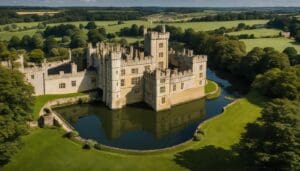Gdansk Travel Guide: Where To Go & What To Visit!
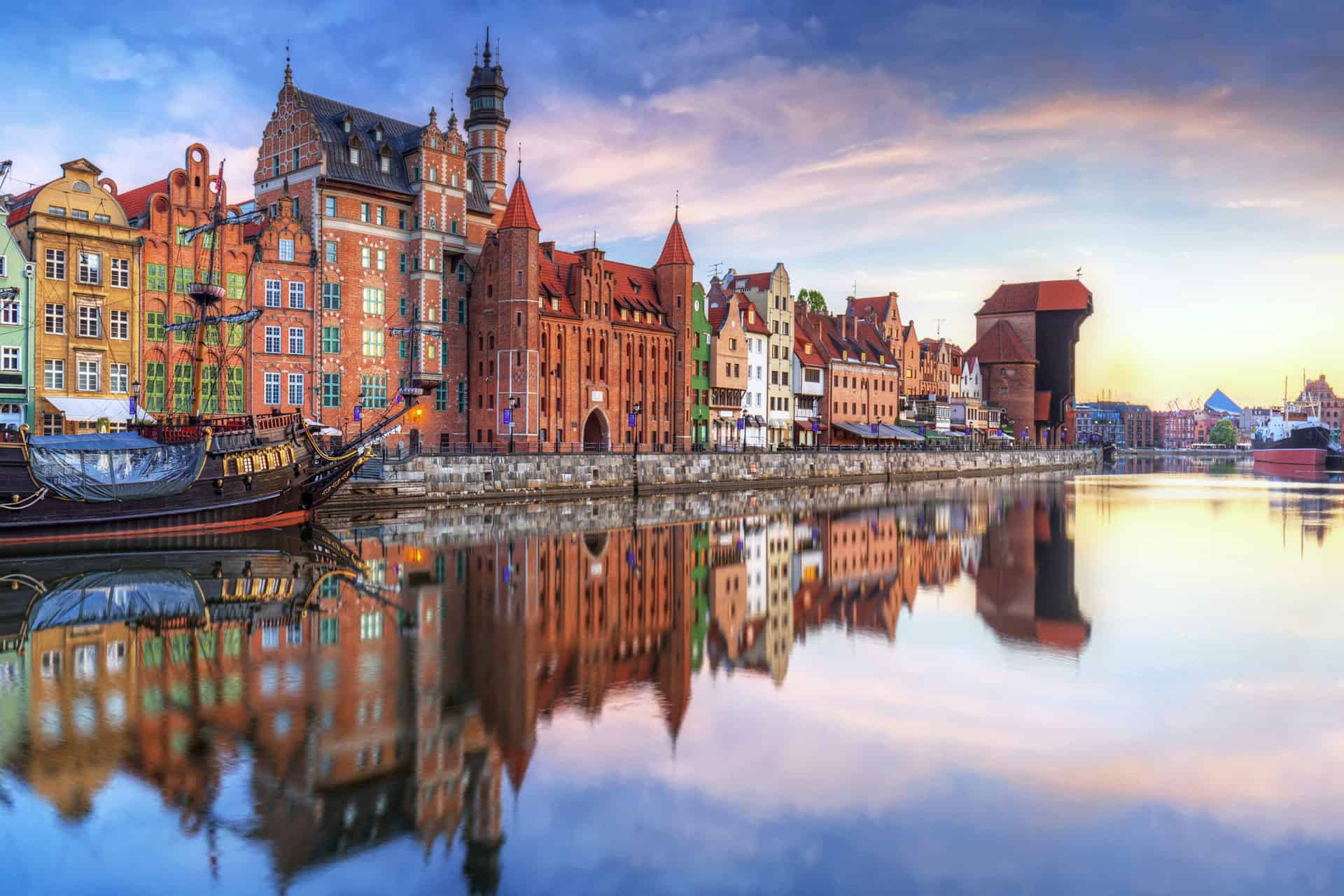
Updated On: November 08, 2023 by Esraa Mahmoud
On the shores of the Baltic Sea lies the largest and most important Polish port, namely the city of Gdansk, AKA the Pearl of the Baltic – from its nickname. The city was one of the largest Hanseatic cities, with cultural and commercial ties to Belgium and the Netherlands. This prosperous era has left its mark on the architecture of Gdansk.
With its 460,000 inhabitants, Gdansk, also known as Danzig, is the 6th largest city in Poland, just behind Poznan, but constitutes, with the cities of Sopot and Gdynia, a conurbation of about one million inhabitants called “the Tricity.” It is located in the north of the country, not far from the Baltic Sea, in the bay of Gdansk.
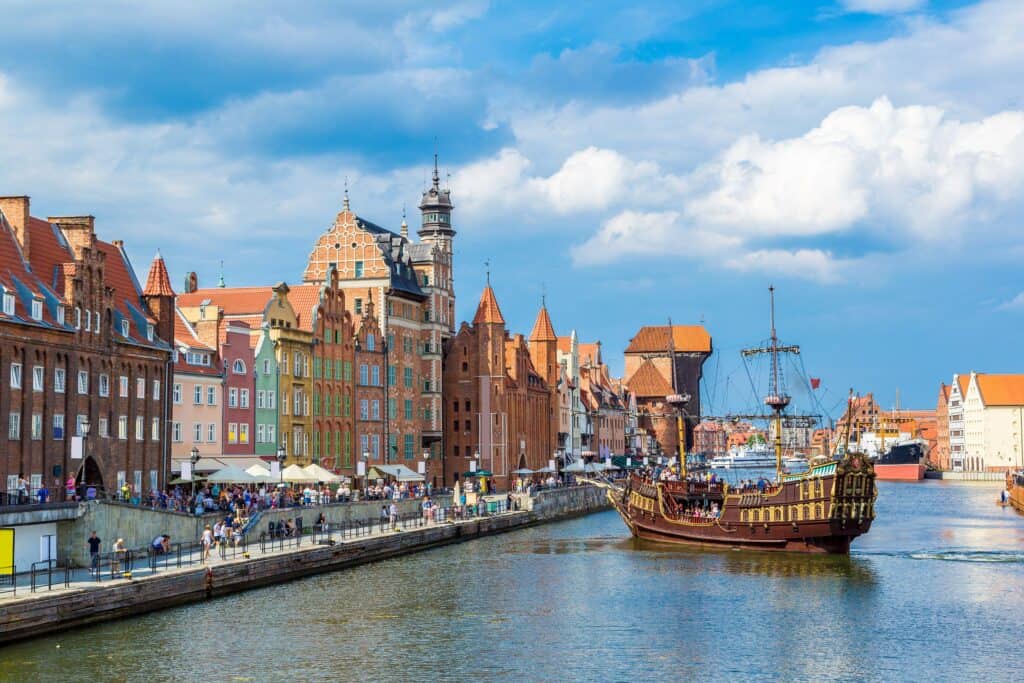
Gdansk was a free city populated mostly by Germans but also by Poles, Jews, and many other minorities, until 1945 when it was permanently attached to Poland. Besides being the largest port in Poland, the city is also a major industrial center, especially with its shipyards, emblematic places of the country’s contemporary history. After all, the Solidarność labor movement led by Lech Wałęsa was born here!
In addition to its economic and commercial importance, Gdansk has attracted many artists throughout its history. Thanks to this, the city has a long tradition of theater and art: festivals, cinemas, modern shows, and classical music or operas – Gdansk is in constant artistic ebullition!
Finally, the capital of Pomerania has, like many cities in Poland, an intense nightlife with many cafes, pubs, and discos. To help you make the best of your stay in the city, here is our list of the best places in Gdansk and top attractions to visit.
The Old Town
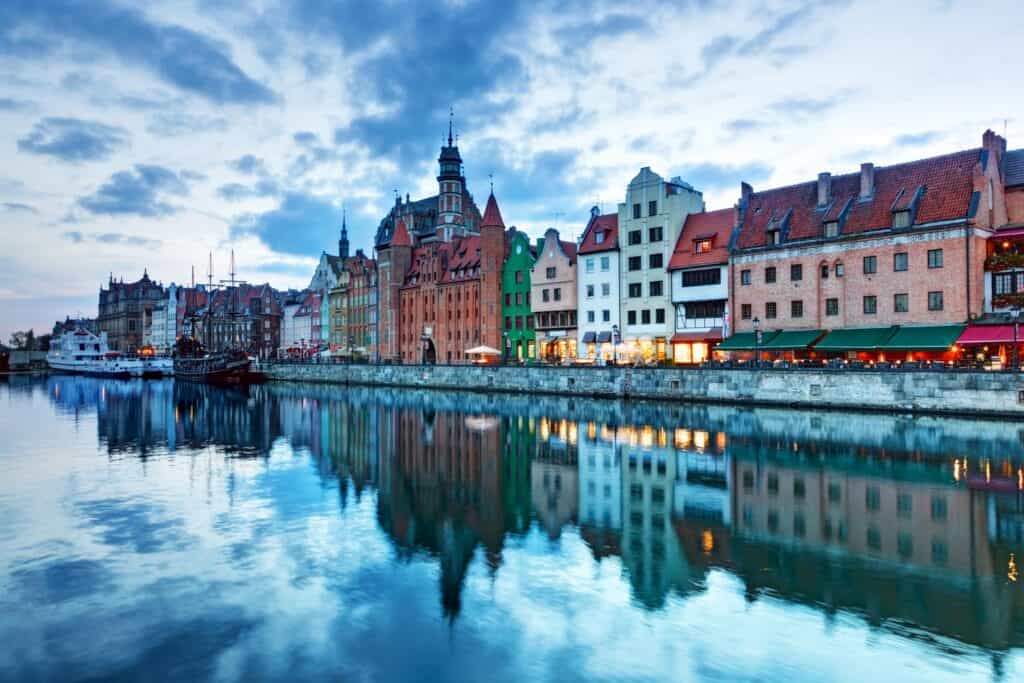
The old town of Gdansk was rebuilt identically, like many other Polish towns, at the end of the Second World War. In spite of this tragic past, it’s a great place to wander around. You will inevitably be seduced by its pretty colored houses, all in height, and its various monuments with breathtaking architecture… such as the big mill, the Artus courtyard, or the Polish postal museum.
The Royal Way
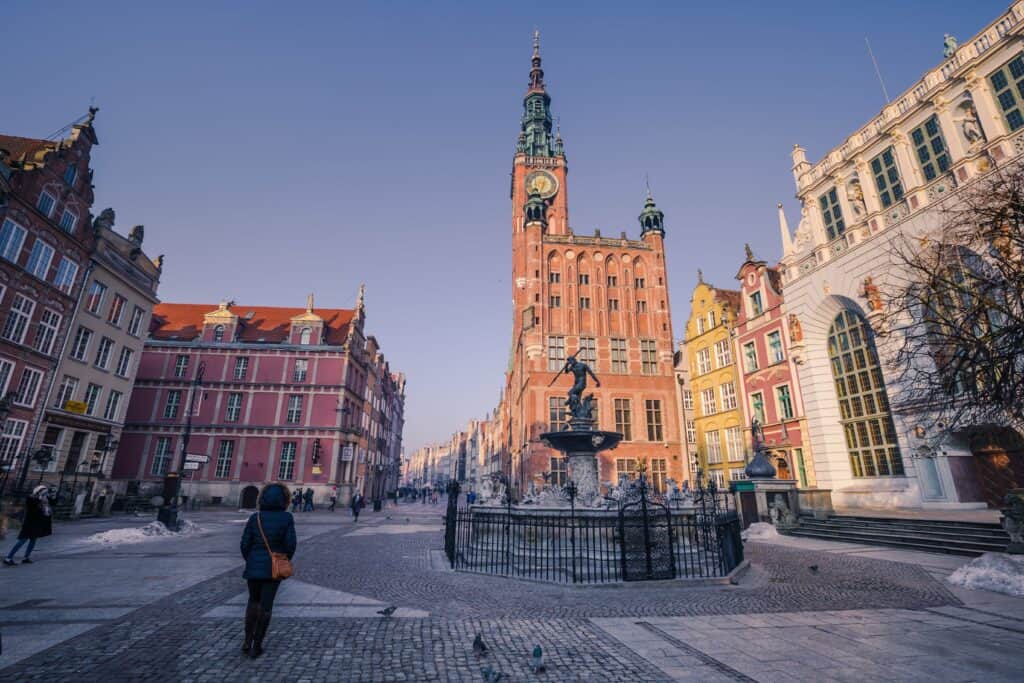
The Royal Way or The Long Lane (Ulica Dluga) is the central artery of the city of Gdansk. Perpendicular to the Motlawa River, it connects each of the two old city gates – the High Gate and the Green Gate. The kings of Poland used to hold their ceremonial parades on this wide street.
It is impossible to visit Gdansk without taking a stroll along the Royal Way and the adjacent streets; it will lead you to see monuments such as the Golden Gate, the Neptune Fountain, the Torture House, or the Prison Tower. It is also an excellent way to discover the history of the city and to admire the magnificent buildings rebuilt after the war, some of which date back to the 14th century.
St. Mary’s Church
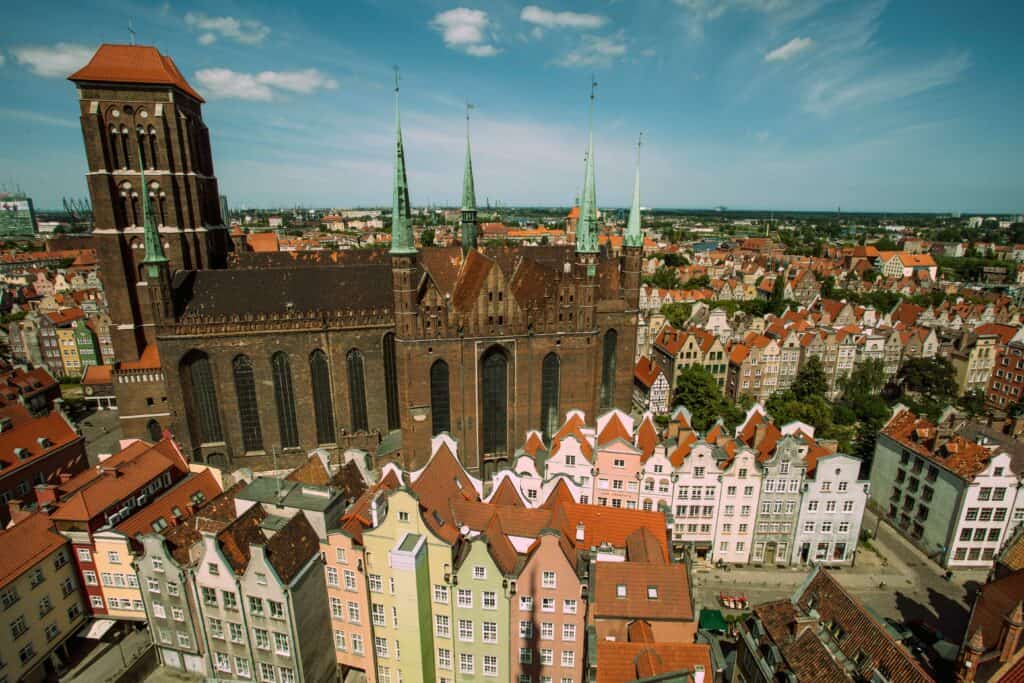
St. Mary’s Church (Bazylika Mariacka) was built between the 14th and 15th centuries, and it is one of the largest brick churches in the world; many say it is even the largest ever. This huge gothic building is located in the center of the city and is an architectural gem both inside and outside.
The church was partly destroyed during World War II, but later it was reconstructed. In the middle of the 20th century, after the restoration, the building was consecrated. Now it is a basilica, which can be visited for free. Inside, you will find a copy of the “Last Judgment” by Memling and a beautiful altar created by M. Schwartz.
At 105 meters long and 66 meters wide, St. Mary’s Church definitely plays in the top league. The astronomical clock, which hangs at the height of 12 meters, chimes daily with a play of figures. From the church tower, you have a magnificent view of the city from a height of 80 meters. Simply marvelous!
Oliwa Cathedral
The famous cathedral, named after Oliwa, is a historic part of the city. In the course of its centuries-long history, the church was repeatedly exposed to destruction and looting. In particular, it suffered heavily from the raids of the Prussians. The building with its two 46-meter-high towers with Baroque cupolas is magnificent.
Equally beautiful are its snow-white interiors with numerous sculptures and natural wood panels. Inside the cathedral is a bas-relief with angels and over twenty altars. As well as a vast 18th-century organ with nearly eight thousand pipes. The feedback from those who have heard the sound of this instrument is consistently enthusiastic! Make sure to visit the cathedral while in the city.
Neptune Fountain
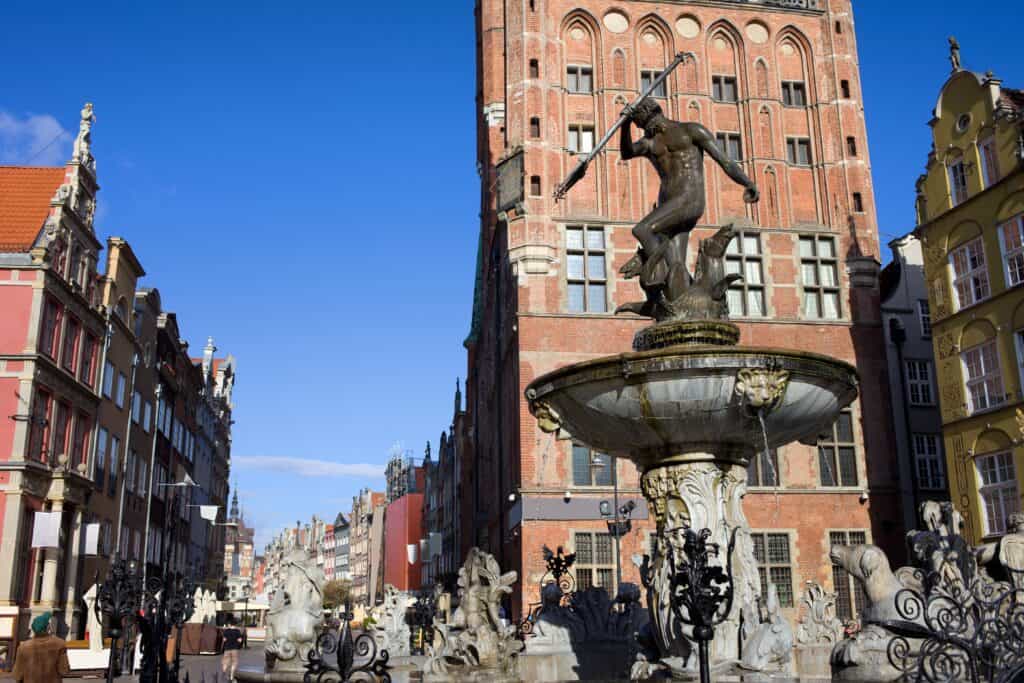
Neptune Fountain is one of the city’s top attractions. It is located in front of the Artus Court on City Hall Square. The sculpture in front of the Artus Palace, depicting the lord of the sea, shows the city’s relationship with the water element. The Monument was built in 1615. If you do not know what to see in Gdansk on your first day, but want to see the main symbols of Poland, then go see the Neptune Fountain, you won’t be disappointed!
Mariacka Street
If you’re wondering what to do in Gdansk, we can only recommend a stroll down Mariacka Street, one of the most beautiful streets in the Old Town. Take the opportunity to admire the beautiful colorful buildings on the street, which are known for their romantic architecture.
This street will charm you by its old-fashioned and melancholic side. Dotted with small terraces and nice cafes, the place is ideal for taking a break and tasting a real Polish vodka, the Goldwasser, with its golden glitter.
Why not end this relaxing moment with an interesting visit to some of the jewelry stores that abound in the basement of the place? Pay a visit to the souvenir stores and especially the small jewelry stores; they all offer pieces with amber, the stone from the Baltic Sea for which the city is famous!
European Solidarity Center
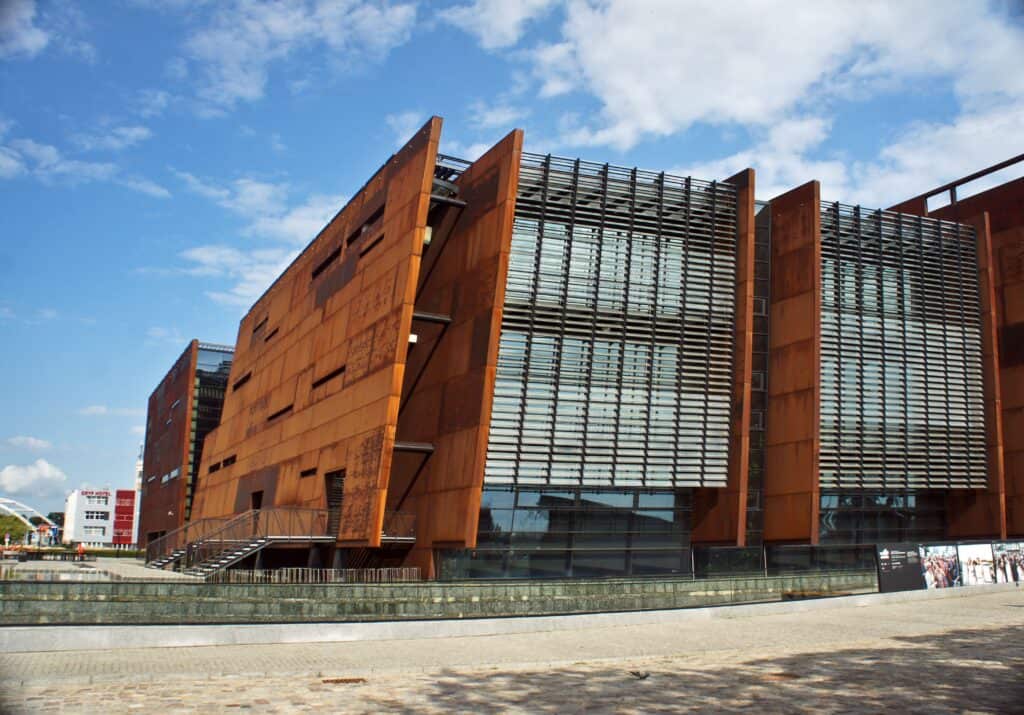
The huge museum is located near the Gdansk shipyards, right behind the Solidarity monument – a must-see memorial. A visit to the museum gives you a better understanding of the history of the Solidarity trade union and how it was able to impose free elections in Poland in the midst of communist rule.
You can also visit the small building in Gdansk where Lech Walesa signed the famous agreement of August 1980, authorizing the Solidarity movement, which precipitated the fall of communism!
National Museum in Gdansk
One of the best things to do in Gdansk is visiting the National Museum. The complex is housed in a former church building. It was rebuilt in the 19th century. Guests of the museum can look at medieval sculptures, pencil drawings, etchings, and thousands of paintings, including such famous masters such as Memling and Möller.
Every Friday, the National Museum in Gdansk offers free admission – don’t hesitate to visit it to learn about local and national history, but also incredible paintings. One, in particular, is worth a visit: “The Last Judgment” by Hans Memling….. It will sweep you off your feet!
Westerplatte
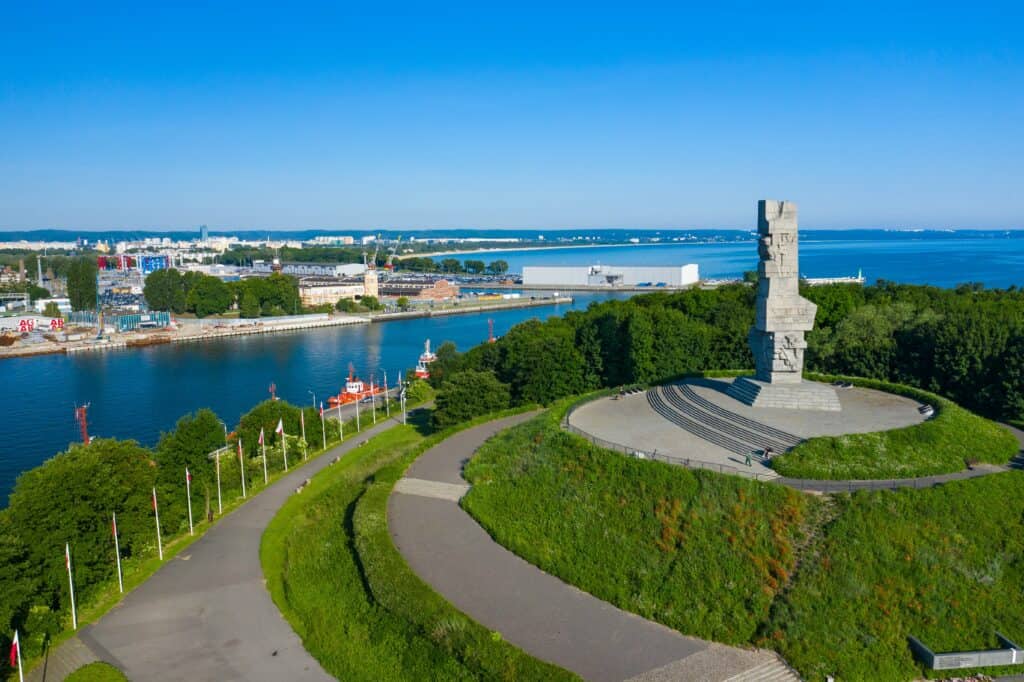
A visit to the Westerplatte peninsula will allow you to discover a little more of the city’s history, as this is where the Germans launched their assault on the city on September 1, 1939. Today, the peninsula is a large outdoor museum and memorial to these tragic events of World War II.
This magnificent peninsula, famous for having been at the heart of the battle of the same name, offers a comforting setting between sandy stretches and majestic forests. The boat ride to get there, full of contrasts, is worth the detour.
You will have the opportunity to observe small, picturesque houses, several classic historical monuments, and the impressive infrastructure of a resolutely modern port. This is a rewarding ride for all levels and shouldn’t be missed when you are in Gdansk, for sure!
The main attraction of the Westerplatte Peninsula is the Westerplatte Monument, also known as the Monument to the Defenders of the Coast. It also includes the remains of a bastion, a cemetery of soldiers killed during World War II, a ruined barracks, and a bunker. The modern coastline, on which the brutal fighting began, is a peaceful and tranquil corner of Gdańsk.
Crane on the Motlawa
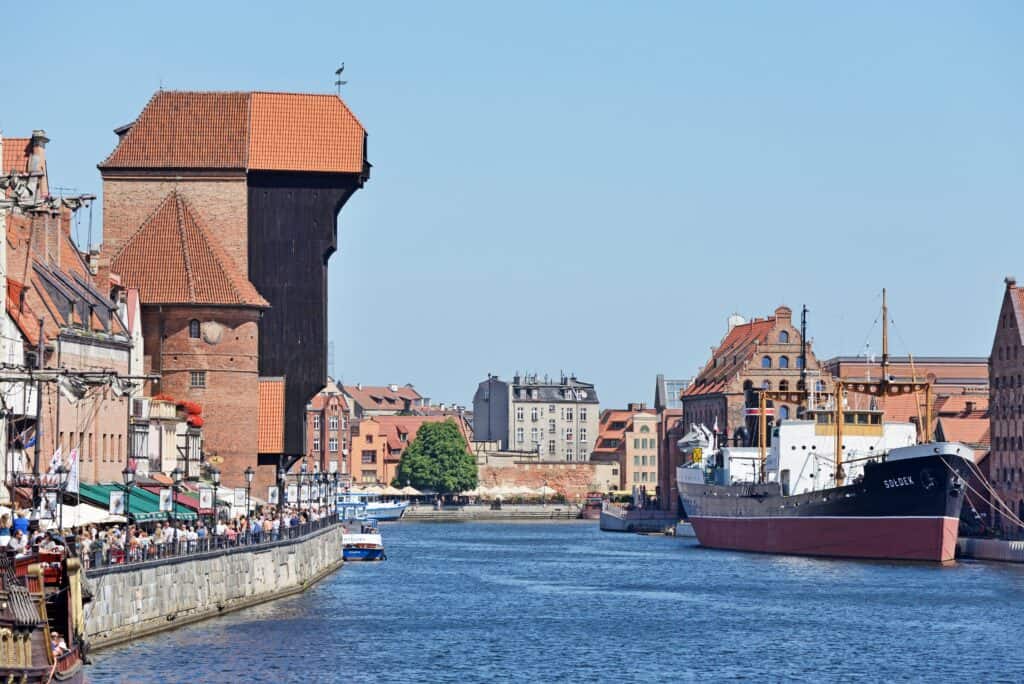
One of the main symbols of Gdansk, which can be seen in any photo, is the Crane on Motława. From afar, the structure appears to be a piece of “Tetris” or a colossal birdhouse. However, in fact, in medieval times, it was a normal port crane.
Crane on Motława was built back in the 15th century, and then (as well as now) it was the largest crane in Europe. “Crane” is capable of lifting loads weighing up to four tons to a height of more than 10 meters. You can explore the structure from the inside, going up to the different floors. There are souvenir stores and restaurants nearby.
The Abbots’ Palace
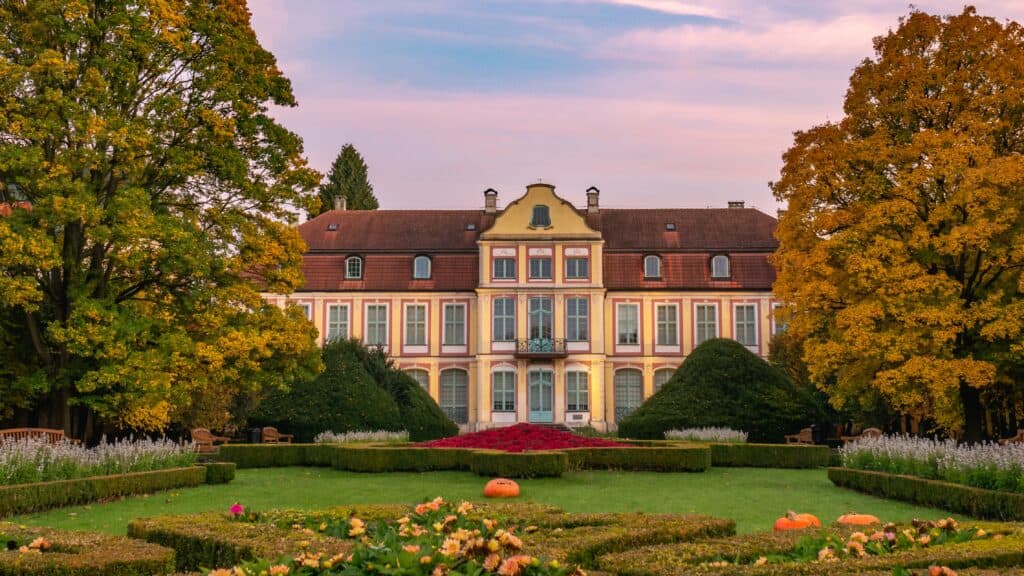
Located in the beautiful Oliwa Park, this rococo-style palace is a wonder in itself. The luxurious Rococo building was rebuilt from the 15th-century Gothic palace. After Poland was partitioned in the 19th century, the structure came into the possession of a prominent German family. The Abbots’ Palace was handed over to the city only at the end of the 20th century.
Visiting it will allow you to discover the very relaxing Oliwa Park and admire the exterior of the palace, but we advise you to take a tour inside as well. The “New Palace” built in the 17th century contains the Department of Modern Arts of the National Museum, in addition to a gallery dedicated to exhibitions of young local artists. The “Old Palace” built in the 15th century is also worth a visit.
World War II Museum
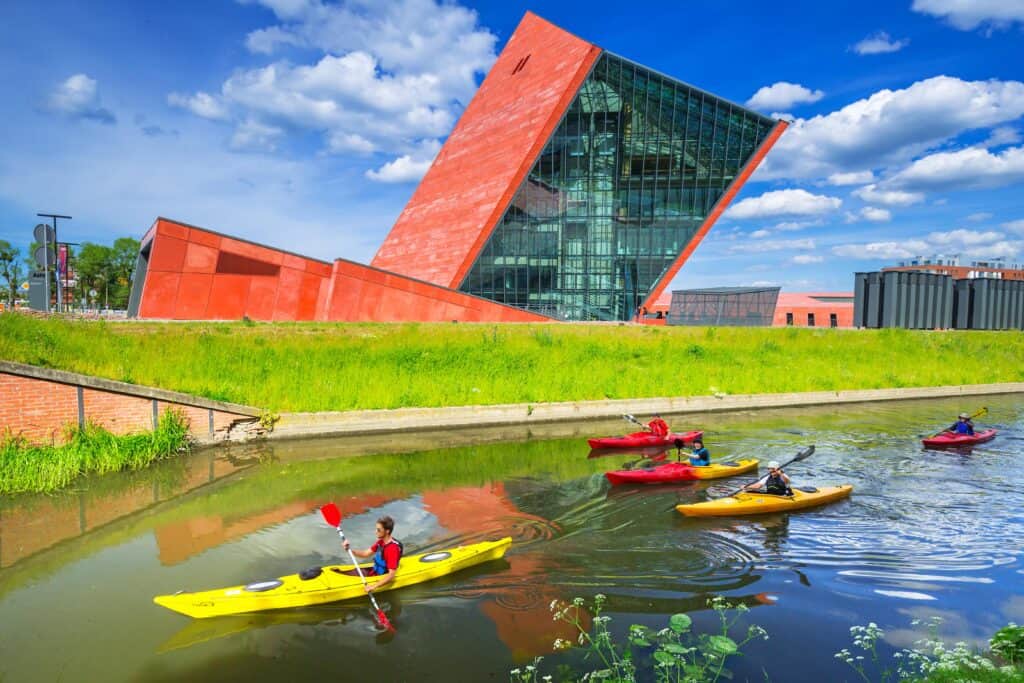
Opened in March 2017, this museum is the newest attraction in Gdansk. The museum dedicated to this terrible conflict allows you to learn more about Poland during World War II, but also aims to feed the memory of Polish heroes and civilians.
The first shots of the Second World War in Poland were heard exactly in Gdansk. The museum exhibits show how the local population lived and what they did during that horrible time. Many of the specimens are interactive. The complex includes several special halls with exhibitions telling about the numerous victims of World War II as well as a bomb shelter.
Archeological Museum
The collection of this museum is so vast that it is housed in several buildings around the city. The main branch works on Mariátska Street and is located in a beautiful Renaissance mansion with stone sculptures at the entrance.
If you do not know what to visit in Gdansk with the whole family and how to spend time with benefit, come here. You will be treated to an unusual attraction – searching for rare objects in the sand. A must-see while at the museum is the permanent exhibition “Mystery of the Nile Valley,” it will blow your mind!
The Amber Museum
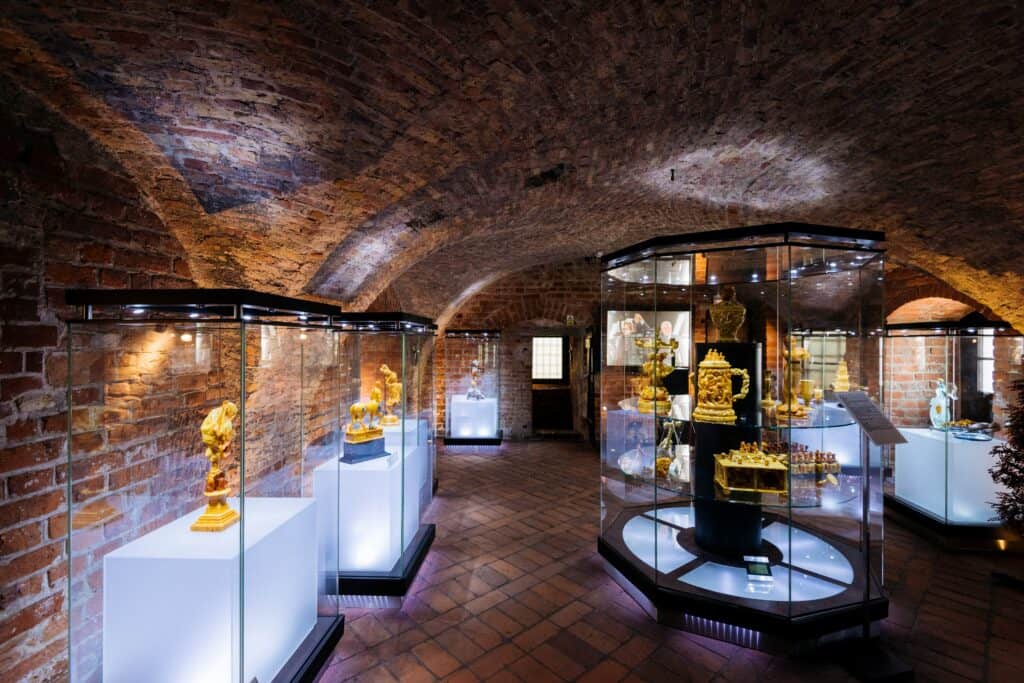
Amber is also called resin from the Baltic Sea and is so closely connected with Gdansk that the city is also called the “golden city.” It is located in a historic complex of buildings that used to house the city prison, as well as the torture chamber.
Part of the museum is still dedicated to the history of the building. In the brick red gothic stick tower, you can still see foot and hand shackles, neck shackles, any kind of rather kinky torture instruments, and the old cells.
On the other hand, the other five floors are less creepy. Here, it’s about the history of origins, profit and trade routes, as well as the artful processing of amber. Super-modern interior design has been combined with the old building, which alone is worth seeing. Multimedia elements and modern installations make the exhibition really interesting.
St. Dominic’s Fair
If you’re planning to visit Gdansk in August, then you’re in luck! During the first three weeks of August, the St. Dominic’s Fair, an exuberant “total festival” dating back to the 13th century, takes place.
The streets of the city come alive as never before: traditional music, festive atmosphere, and nightly entertainment, all-day market, food stalls – this is a festival you will remember for years to come, and by far the most famous in Poland!
Golden Gate
From the Golden Gate, almost all of Gdansk Old Town begins. Walk down any street leading from this gate, and you’ll find many amazing medieval-style mansions. There are ruined and reconstructed attics on the gates that are worth seeing as well.
Green Gate
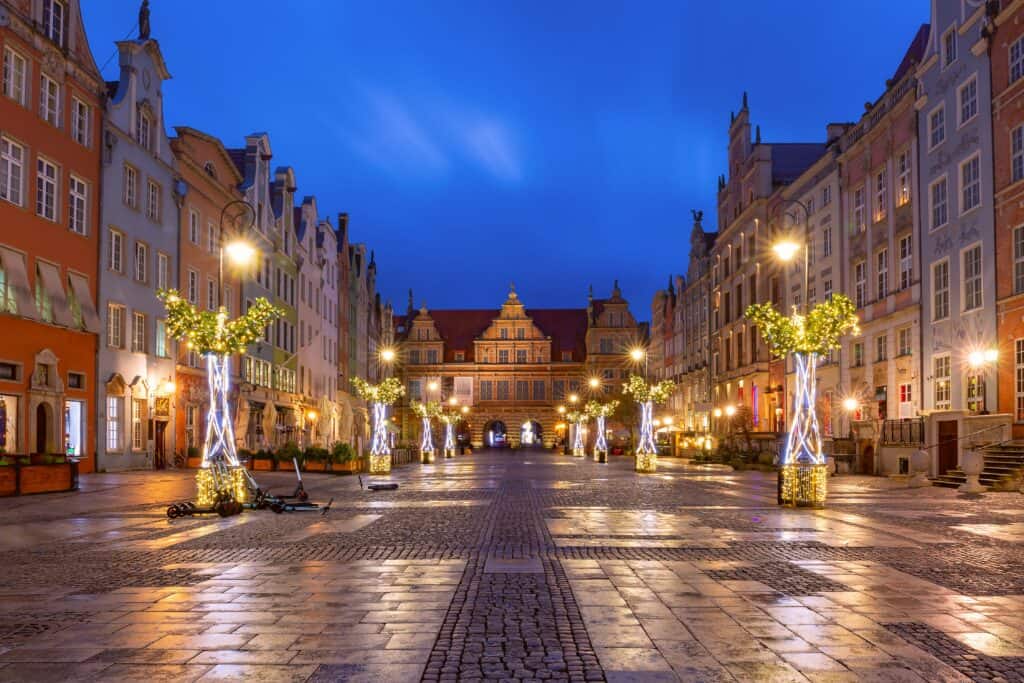
The Gdansk Green Gate, with its four arches, sculptures, windows, and roof on the Marcin Białek Royal way, is one of the most famous sights of Gdansk. The construction, made of small Dutch bricks, was completed in the middle of the 16th century. It was supposed to be the residence of the Polish monarchs.
However, apart from Maria Luisa, other members of the royal family did not stay in the building. The Green Gate is shaped like a palace with four entrances. Inside is now the National Museum of Gdansk. It also hosts important conferences, business meetings, and official celebrations.
Artus Court Gdansk
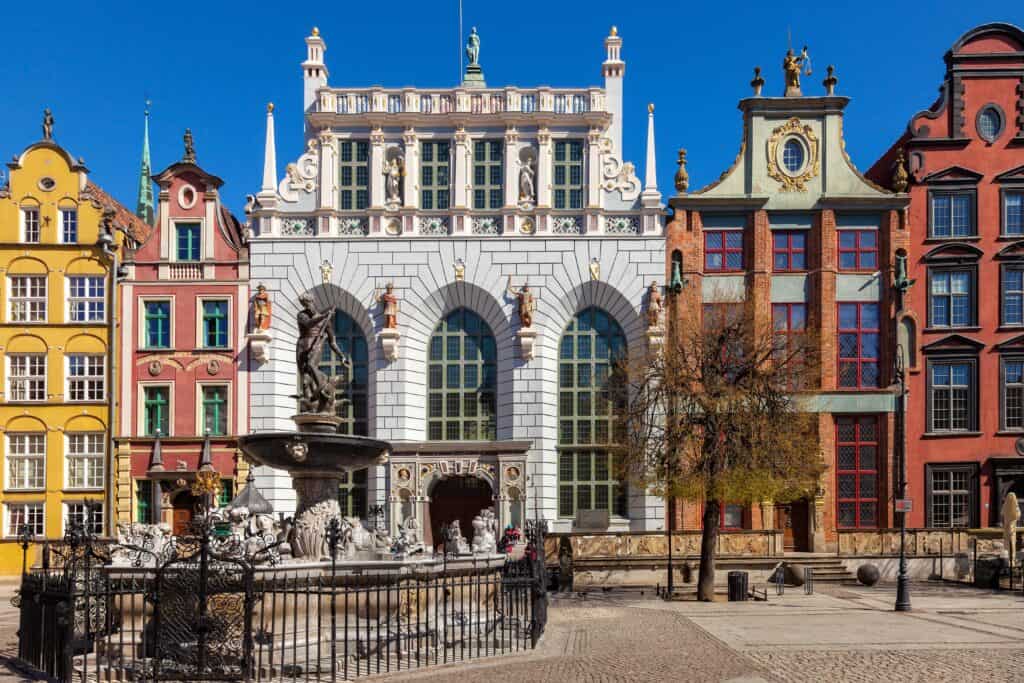
This particular building has an incredible historical heritage. Its famous red hall with a splendid ceiling is dazzling and luxurious. Climb the few steps to the top of the belfry to enjoy a sensational view! This little climb to do in Gdansk grants you a unique moment of contemplation on the old city and its orange roofs!
Gdansk Zoo
The Gdansk Zoo, with an area of about 135 hectares, is home to animals from literally every continent on earth. The inhabitants include such rare animals as pygmy hippos and Bongo antelopes. For younger guests, there is a mini menagerie with guinea pigs, rabbits, goats, etc.
Animals can be picked up and fed. A part of the zoo is set aside for the placement of figures of ancient animals in full size, including dinosaurs and lizards.
The Great Arsenal
The 17th-century landmark, Great Arsenal, formerly used as a warehouse for gunpowder and weapons, is located at the beginning of Beer Street. It is a building with figures of guards on the facade and original pediments.
The Great Arsenal, AKA the Great Armory, impresses with its magnificent facade and many turrets and gables. The armory houses a shopping mall on the lower floors and the Academy of Fine Arts on the upper levels.
Prison Tower
In the 14th century, the Prison Tower was part of the fortress defense. The building was destroyed and rebuilt in the 15th and 16th centuries. That is why its appearance was significantly changed. In the 17th century, the torture of the arrested was carried out in the Prison Tower.
The prisoners sentenced to death were executed there. Now there is a museum inside the tower with sculptures, jewelry, icons, and other items made of amber.
The Great Mill
The Great Mill is an industrial building from the 14th century, built by the Teutonic Knights. It is the largest and most large-scale building in Europe, built and used for industrial purposes.
Looking at the facility from the outside, you can understand what the ancient mills looked like. Inside is a shopping center. However, the mill wheels remained in their original place.
Town Hall of the Main City
The Town Hall of the Main City is located in the central part of the town square. Initially, it was built in Gothic style, but after a fire, in the 16th century, the facade acquired Renaissance elements. One of the main decorations of the building is an 80-meter dome topped with a statue of Sigismund the Second in gilt.
You can see the town hall not only from the outside but also from the inside. The Red Hall is particularly rich and splendid. After exploring the interiors, guests can pay a visit to a local restaurant, cafe, and cultural center. A visit to such attractions in Gdańsk is a must.
Wijkselmünde
Wijkselmünde is a round tower in the center of the fortress of Weixelmünde, surrounded by a brick ring and Konik Morski houses. Like many other landmarks in Poland, this one has a rich and long history.
The fortress was built back in the 15th century. In its appearance, you can notice elements of various architectural styles. The site is of national importance as a historical monument. Until the 18th century, the main tower of the fortification was a lighthouse.
Ferris Wheel
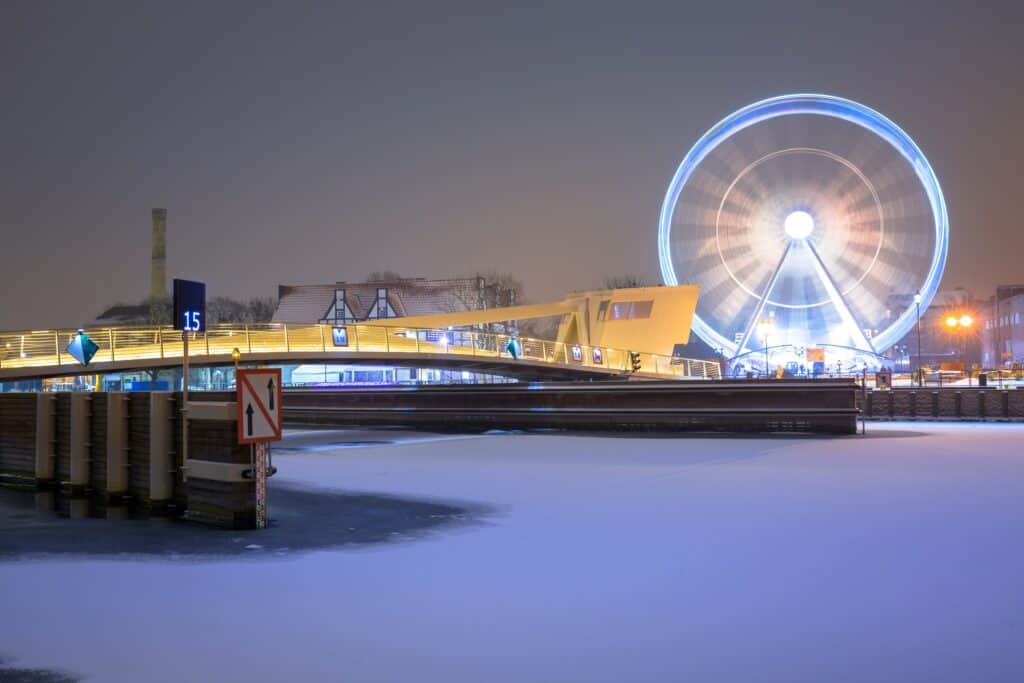
The Ferris wheel on the northern part of Spixzów on the banks of the Moltawa River in Gdansk is the highest Ferris wheel in Europe, which takes half an hour to complete a full turn. The construction with 43 cabins and a height of over 50 meters started its operation about five years ago. The wheel weighs 350 tons.
Reda Waterpark
Reda Waterpark is one of the newest and largest water parks in Poland (opened in 2016), able to accommodate a massive number of tourists. The area of the water park is closed, but there are several outdoor terraces with loungers. As well as other entertainment parks in Gdansk, Reda is designed for both young and adult guests.
Jelitkovo Beach
The water temperature of the Balkan Sea is cool. However, when you come to Gdansk, you should not miss out on the chance to rest on the golden sands of the city beach Jelitkowo. The area is well equipped as there are entertainment areas for kids, cafes, cycling, jogging paths, and a green park.
Enjoy Some Local Culinary Specialties
Discovering a place is never completer without exploring this place’s cuisine. For the greatest pleasure of your taste buds, don’t hesitate to try the roasted meat compote, a traditional dish of the region.
Pierogi, a must of Polish cuisine, will also surprise you with its original stuffing made of potatoes, cheese, cabbage, mushrooms, or even blueberries. Do you prefer fish? Try the soup; you won’t be disappointed!
The old Hanseatic city of Gdansk has a lot to offer. It is known for its handicrafts, ship models, and amber, but it will also enchant you with its beautiful beaches, colorful old town, beautiful harbor, small cafes, and a variety of historical buildings. The city has everything needed to make it to everybody’s bucket list!




